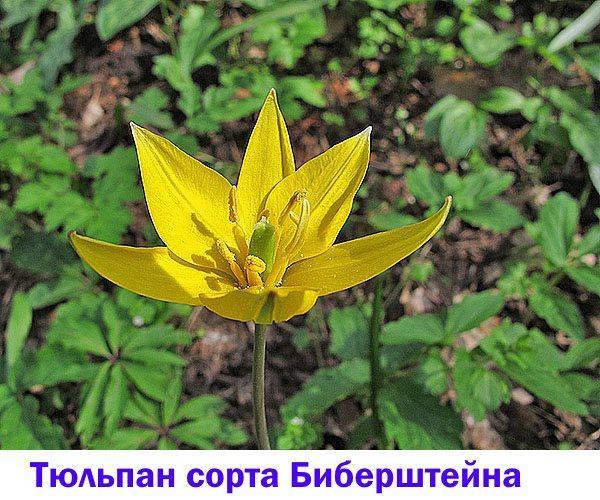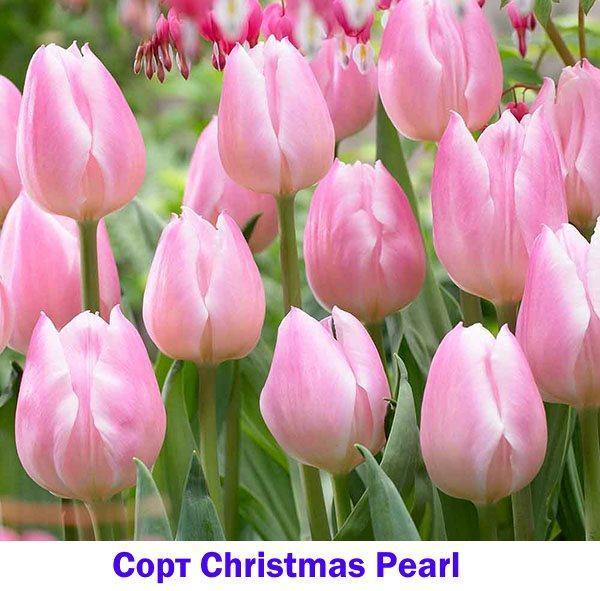We study tulip varieties by photo with names
 Tulips have long been the subject of admiration in the East, once in Europe, they caused a flurry of passions, becoming one of the most beloved and widespread garden plants. Today, flower growers have varieties of tulips at their disposal, the photos and names of which will certainly cause a desire to decorate their plot with these flowers.
Tulips have long been the subject of admiration in the East, once in Europe, they caused a flurry of passions, becoming one of the most beloved and widespread garden plants. Today, flower growers have varieties of tulips at their disposal, the photos and names of which will certainly cause a desire to decorate their plot with these flowers.
The huge number of wild and cultivated varieties forced botanists and tulip connoisseurs to create and constantly improve a special classification, which includes several classes and groups. Take a look on a tulip tree!
The Netherlands has historically been the world center for tulip breeding. Having come here many centuries ago, the bulbous culture has become the love and work of life of entire dynasties. Therefore, both proven old and incredibly spectacular new Dutch tulips are still the basis of every collection.
Plants are divided into early, middle and late flowering periods. According to the flower shape and origin, tulips are divided into fifteen classes, most of which are given to the Gesner and Foster tulip hybrids.
Read also the article: peony roses - beauty on your site!

Group of early blooming tulips
Photos of tulips and the names of varieties of early flowering periods always arouse keen interest in flower growers. This is not surprising, because in the first warm days you want bright colors so much. Among the spring bulbs, tulips have the largest flowers. However, early varieties of simple and double tulips are inferior in height and variety to their later counterparts.
 Simple early tulips or Tulipa single early are grouped into Class 1. Plants up to 40 cm high with relatively medium-sized corollas belong to the Gesner and Schrenck tulips. Depending on the variety, the size of a glass-like flower reaches 5–7 cm. The colors of flowers are dominated by red and yellow tones. Although there are more original colors, for example, the delicate purple tulip of the Purple Prince variety shown in the photo.
Simple early tulips or Tulipa single early are grouped into Class 1. Plants up to 40 cm high with relatively medium-sized corollas belong to the Gesner and Schrenck tulips. Depending on the variety, the size of a glass-like flower reaches 5–7 cm. The colors of flowers are dominated by red and yellow tones. Although there are more original colors, for example, the delicate purple tulip of the Purple Prince variety shown in the photo.
 Recently, the popularity of early varieties of tulips blooming since mid-April has been growing, which is facilitated by the possibility of forcing flowers, but strong, but short flower stalks are not always suitable for cutting.
Recently, the popularity of early varieties of tulips blooming since mid-April has been growing, which is facilitated by the possibility of forcing flowers, but strong, but short flower stalks are not always suitable for cutting.
 Forming Class 2 Tulipa Double Early early double tulips were first obtained shortly after the emergence of the culture in the Old World. The English name of the group literally translates as "double", which accurately describes the structure of the flower, as it were, consisting of two nested corollas.
Forming Class 2 Tulipa Double Early early double tulips were first obtained shortly after the emergence of the culture in the Old World. The English name of the group literally translates as "double", which accurately describes the structure of the flower, as it were, consisting of two nested corollas.
Today breeders offer flower growers to grow incredibly lush flowers with additional petals. Plants of this type are short, sturdy, bloom for up to two weeks and are excellent for growing in pots, as well as for spring forcing.
Varieties, photo and name of medium flowering tulips
The second group of plants unites the most common and popular tulips of Darwin and Triumph.
 Included in Class 3, Triumph tulips are a composite group of plants with simple large flowers crowning stems up to 70 cm high. Varieties dating back to the beginning of the last century and new varieties are excellent for mass cultivation.Flower growers are attracted by the strong flower stalks of tulips and perfectly shape-retaining flowers, shaped like graceful wine glasses. Flowering begins in the last decade of April and lasts 7–12 days.
Included in Class 3, Triumph tulips are a composite group of plants with simple large flowers crowning stems up to 70 cm high. Varieties dating back to the beginning of the last century and new varieties are excellent for mass cultivation.Flower growers are attracted by the strong flower stalks of tulips and perfectly shape-retaining flowers, shaped like graceful wine glasses. Flowering begins in the last decade of April and lasts 7–12 days.
 Due to their size, stable flowering and the presence of not only red, but also yellow, pink tulips, plants with white, deep purple and even two-color corollas, mid-early varieties are recognized by landscape designers, ordinary florists and those who are partial to tulips in bouquets. The interest of summer residents in the group is supported by:
Due to their size, stable flowering and the presence of not only red, but also yellow, pink tulips, plants with white, deep purple and even two-color corollas, mid-early varieties are recognized by landscape designers, ordinary florists and those who are partial to tulips in bouquets. The interest of summer residents in the group is supported by:
- unpretentiousness of varieties;
- universality of appointment;
- an abundance of colors;
- large flowers that keep their shape and freshness for a long time;
- easy vegetative propagation;
- the ability to use for forcing in the middle and late periods.
Tall, resistant to viral diseases and highly variable due to their tendency to mutation, Darwin's hybrids compete with the Triumph tulips on a par with the Triumph tulips and form Class 4, as extensive as the previous one.
 These plants owe their popularity to the tulip variety shown in the photo with the name Apeldoorn, which fully manifested the ability to produce offspring during vegetative propagation, unlike the parent plants.
These plants owe their popularity to the tulip variety shown in the photo with the name Apeldoorn, which fully manifested the ability to produce offspring during vegetative propagation, unlike the parent plants.
 Another variety widely known in the territory of the former Soviet Union is the Parade tulip, obtained back in the 50s and still decorating the streets of Russian cities and flower beds of summer residents.
Another variety widely known in the territory of the former Soviet Union is the Parade tulip, obtained back in the 50s and still decorating the streets of Russian cities and flower beds of summer residents.
 The yellow tulip shown in the photo, closely related to the previous variety, is called Golden Parade and is rightfully considered one of the largest mid-early varieties in the family.
The yellow tulip shown in the photo, closely related to the previous variety, is called Golden Parade and is rightfully considered one of the largest mid-early varieties in the family.
All Darwin's hybrids are more often characterized by red or two-color coloration of large corollas, about 10 cm in height. Flowers in sunny weather can fully open, which speeds up their fall.
Late flowering tulips: peony, simple and other classes
This group is the most extensive and variegated, both in color and in the shape of the corollas, the flowers combined into it. Tulips form seven independent classes, some of which are actively developing, and some will soon become history.
 Class 5 includes cultivars of late simple tulips or Tulipa Single Late with flower stalks up to 75 cm high and egg-shaped corollas. The petals of these tulips are rounded, and the bottom of the flower forms an almost regular square. This class is incredibly diverse. Any colors and their combinations are possible here.
Class 5 includes cultivars of late simple tulips or Tulipa Single Late with flower stalks up to 75 cm high and egg-shaped corollas. The petals of these tulips are rounded, and the bottom of the flower forms an almost regular square. This class is incredibly diverse. Any colors and their combinations are possible here.
White and black tulips look very impressive next to them, which in the photo are represented by the Queen of Night variety. The varieties blooming in mid-May are excellent in the flowerbed and in the cut, but they are not suitable for distillation, since they have been dormant for too long.
The extraordinarily dainty tulips Tulipa Lilyflowering form Class 6.
 These plants are from Turkey, due to their low endurance, spread in Europe relatively recently. The main feature of the representatives of the class is the pointed petals, which form a refined, lily-like corolla. The height of the peduncles is 50 - 60 cm.
These plants are from Turkey, due to their low endurance, spread in Europe relatively recently. The main feature of the representatives of the class is the pointed petals, which form a refined, lily-like corolla. The height of the peduncles is 50 - 60 cm.
 In the palette of lily-colored tulips, white, as in the photo, pink, lilac, yellow and red tones, as well as their numerous combinations.
In the palette of lily-colored tulips, white, as in the photo, pink, lilac, yellow and red tones, as well as their numerous combinations.
In Class 7, flowers of all shapes can be seen, from simple to lily or terry.
 However, all varieties will have one common feature - the presence of a needle-like fringe at the edges of the petals. The first flowers of this variety were seen in the first half of the last century, and since then, unusual varieties for cutting and landscape decoration appear more and more often.
However, all varieties will have one common feature - the presence of a needle-like fringe at the edges of the petals. The first flowers of this variety were seen in the first half of the last century, and since then, unusual varieties for cutting and landscape decoration appear more and more often.
 One of the newest sections of the garden classification - Class 8 is formed by the green-flowered tulips Tulipa Viridiflora, obtained from the fixed mutation of simple plants.
One of the newest sections of the garden classification - Class 8 is formed by the green-flowered tulips Tulipa Viridiflora, obtained from the fixed mutation of simple plants.
 You can distinguish it from your fellows by a wide green stripe running along the central lily of each petal. Because of it, tulip buds look green for a long time, and their true color appears only at the stage of dissolution. The white tulip of the Spring Green variety shown in the photo is the most popular in the class.
You can distinguish it from your fellows by a wide green stripe running along the central lily of each petal. Because of it, tulip buds look green for a long time, and their true color appears only at the stage of dissolution. The white tulip of the Spring Green variety shown in the photo is the most popular in the class.
 The medium and large height of the peduncles made tulips of this class available both for decorating the plot and for cutting.
The medium and large height of the peduncles made tulips of this class available both for decorating the plot and for cutting.
If the eighth class is new, then the class 9, intended for Rembrandt variegated tulips, has no development prospects. This commonality of varieties, well known from the paintings of Dutch and Flemish painters of the 17th – 18th centuries, is today actually abolished, and the varieties remaining after the reorganization of the class have been transferred to other groups.
 The reason for this is the fixation of a dangerous variegation virus in the plant, which causes the appearance of stripes and strokes of contrasting shades on the petals.
The reason for this is the fixation of a dangerous variegation virus in the plant, which causes the appearance of stripes and strokes of contrasting shades on the petals.
 Parrot tulips with fancy petals reminiscent of exotic bird feathers form Class 10. Plants of this variety are distinguished not only by their bizarre corolla shapes, but also by their size.
Parrot tulips with fancy petals reminiscent of exotic bird feathers form Class 10. Plants of this variety are distinguished not only by their bizarre corolla shapes, but also by their size.
 The flower diameter can be up to 20 cm, which imposes its own requirements on the strength of the peduncles. The stems of parrot tulips are really strong, but not too tall, growing up to 40-60 cm. To prevent loss of flowers due to wind or heavy rain, plants provide reliable protection, and sometimes support.
The flower diameter can be up to 20 cm, which imposes its own requirements on the strength of the peduncles. The stems of parrot tulips are really strong, but not too tall, growing up to 40-60 cm. To prevent loss of flowers due to wind or heavy rain, plants provide reliable protection, and sometimes support.
 Double late tulips forming Class 11 are called Tulipa Double Late by analogy with the early ones. However, this group has another name, caused by the beautiful shape of a large flower - peony tulips.
Double late tulips forming Class 11 are called Tulipa Double Late by analogy with the early ones. However, this group has another name, caused by the beautiful shape of a large flower - peony tulips.
 Compared to the double flowers that open in the last days of April, the corollas of the late varieties are much more massive and thicker, as, for example, in the descendant of the tulip Apeldoorn, the double beauty of Apeldoorn.
Compared to the double flowers that open in the last days of April, the corollas of the late varieties are much more massive and thicker, as, for example, in the descendant of the tulip Apeldoorn, the double beauty of Apeldoorn.
 Like parrot tulips, late terry varieties with heavy heads need support and planting in a place protected from the wind. With regular care and attention, these plants with stems up to 60 cm will create a carpet of incredible beauty and brightness in a flower bed.
Like parrot tulips, late terry varieties with heavy heads need support and planting in a place protected from the wind. With regular care and attention, these plants with stems up to 60 cm will create a carpet of incredible beauty and brightness in a flower bed.
 Recently, special attention of flower growers has been given to the Ice Cream tulip with superficial petals of a juicy berry shade and a snow-white core, reminiscent of a horn with a favorite summer delicacy. Although the variety is relatively new, a photo of the tulip Ice cream today adorns not only the catalogs of bulb growers, but also the sites of Russian summer residents.
Recently, special attention of flower growers has been given to the Ice Cream tulip with superficial petals of a juicy berry shade and a snow-white core, reminiscent of a horn with a favorite summer delicacy. Although the variety is relatively new, a photo of the tulip Ice cream today adorns not only the catalogs of bulb growers, but also the sites of Russian summer residents.
Specific tulips: the fourth group in the garden classification
The fourth group is species tulips used in breeding cultivars and grown as independent ornamental plants.
 Class 12 is given to Kaufman tulips, which bloom already in March, can reach a height of 30 cm, and their flowers with pointed petals of different colors are always organic on low curbs and rocky hills.
Class 12 is given to Kaufman tulips, which bloom already in March, can reach a height of 30 cm, and their flowers with pointed petals of different colors are always organic on low curbs and rocky hills.
Foster's tulips, the tallest of the species, are distinguished not only by this, but also by their large flowers, which made it possible to use the plants to obtain many modern varieties belonging to other groups and classes. Foster's tulip buds open in April and immediately draw attention to themselves with the unusual petals bent at the top.
 The specific Greig tulips and their hybrids forming Class 14 are easily distinguished by their patterned leaves covered with colored stripes and strokes. Although plants of this species are not distinguished by high growth, due to their high decorative effect and long flowering, they are always welcome guests on the site.
The specific Greig tulips and their hybrids forming Class 14 are easily distinguished by their patterned leaves covered with colored stripes and strokes. Although plants of this species are not distinguished by high growth, due to their high decorative effect and long flowering, they are always welcome guests on the site.
Class 15 contains species of wild tulips. Compared to their garden descendants and relatives, these species, often called botanical, are shorter, better adapted to harsh conditions. In addition, full of charm, medium-sized flowers are less affected by diseases or completely resistant to them.